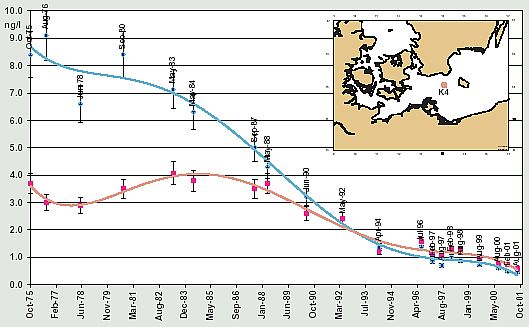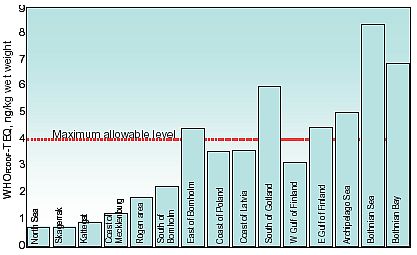Heavy metal concentrations in the water still high
Heavy metal concentrations in the Baltic Sea are many times higher than in the northern Atlantic, and have not decreased since the 1990s.
Table 1: Concentrations of dissolved trace metals (ng/kg) from the North Atlantic and the Baltic Sea. Kremling, K. & Streu, P. (2001); Pohl, C. et al. (1993); Pohl, C. et al. (2005); Dalziel, J. A. (1995)
| Element | North Atlantic | Baltic Sea | Factor |
| Mercury | 0.15-0.3 (4) | 0.5-1.5 (3) | ~ 5 |
| Cadmium | 4 (+-2) (1) | 12-16 (3) | ~ 4 |
| Lead | 7 (+-2) (1) | 12-20 (3) | ~ 3 |
| Copper | 75 (+-10) (2) | 500-700 (3) | ~ 10 |
| Zinc | 10-75 (1) | 600-1000 (3) | ~ 10-50 |
Concentrations of cadmium and copper declined by about 6% per year between the 1980s and the mid-1990’s. Since 1993, concentrations of trace metals in seawater have generally remained stable (see the relevant HELCOM Indicator Fact Sheet for further information). Concentrations of cadmium, lead and zinc are on average higher in the south-western parts of the Baltic Sea, where atmospheric deposition of heavy metals is greater and waste containing high levels of heavy metals has been dumped.
Heavy metals in marine organisms
Even though the concentrations of some heavy metals have decreased in many parts of the Baltic Sea, high concentrations can still be found in certain marine organisms, notably in Baltic herring. Since the 1980s, lead concentrations in herring have generally decreased.
These declining trends are probably caused by the reduced atmospheric input of lead pollution, due in turn to the removal of lead from petrol.
Cadmium concentrations in Baltic herring have increased significantly, despite a general declining trend in concentrations in the waters of the Baltic Proper and the Western Baltic Sea.
Mercury concentrations in herring have remained at roughly the same level since the 1980s.
Persistent organic pollutants (POPs)
Since their complete bann in the 1980's, several POPs, notably certain organochlorine pesticides such as DDT and technical grade HCH, have considerably decreased in the waters of the Baltic Sea. After a sharp decrease over the period 1983–1993 a levelling off was observed until 1999, when a downward trend began, leading to a further decrease of more than 30% by 2001.
Concentrations of polychlorinated biphenyls and lindane in herring have both decreased significantly, probably due to the effect on emissions of stricter regulations and bans in the HELCOM countries.
Measurements taken in 2001 in marine snails show relatively high concentrations of TBT in the Danish estuaries, the Kattegat, the Sound and the Belt Sea and the Western Baltic Sea. Imposex and intersex reproductive and gender disorders induced by TBT are consequently widespread in the Danish Straits and coastal areas.

Dioxins in the Baltic Sea food web
Because of their emission routes dioxins are spread all over the Baltic Sea area. Since dioxins are persistent and bio-accumulative, they become more concentrated as they move up the food chain. Large quantities are stored in seabed sediments, accumulated over several decades. Smaller quantities are still reaching the Baltic Sea, although releases have decreased during the last 10-20 years.
Fatty fish contain dioxins
The fat-soluble properties of dioxins cause them to accumulate in fatty tissues. Herring and salmon are fatty fish, and contain the highest dioxin concentrations when calculated by fresh weight. The degree of contamination varies geographically, from year to year and according to the season (highest in the spring), the fat content, and also the size and age of the fish.

Dioxins, risk to human health – threat to fish lovers?
The nutritional qualities of fi sh are well known. In addition to being a good source of animal protein and fatty acids, fish contain vitamins A and D, magnesium, phosphorus and mineral salts. Recent studies show that fatty fish contain certain fatty acids vital to the development of the human brain in the foetus and in infants.
In recent years however, we have seen the emergence of a number of threats to the quality of human food. The issue of dioxins in human food led to the adoption by the European Council of a Regulation establishing maximum levels of dioxin and other contaminants in both human food and animal feed. The limits apply from 1 July 2002 and will be reviewed by 31 December 2004. The overall goal is to reduce human exposure to dioxins by at least 25% by the year 2006. Other measures include the creation of the European Food Safety Authority and mandatory labelling of fish.
Click here for further information about dioxins.

